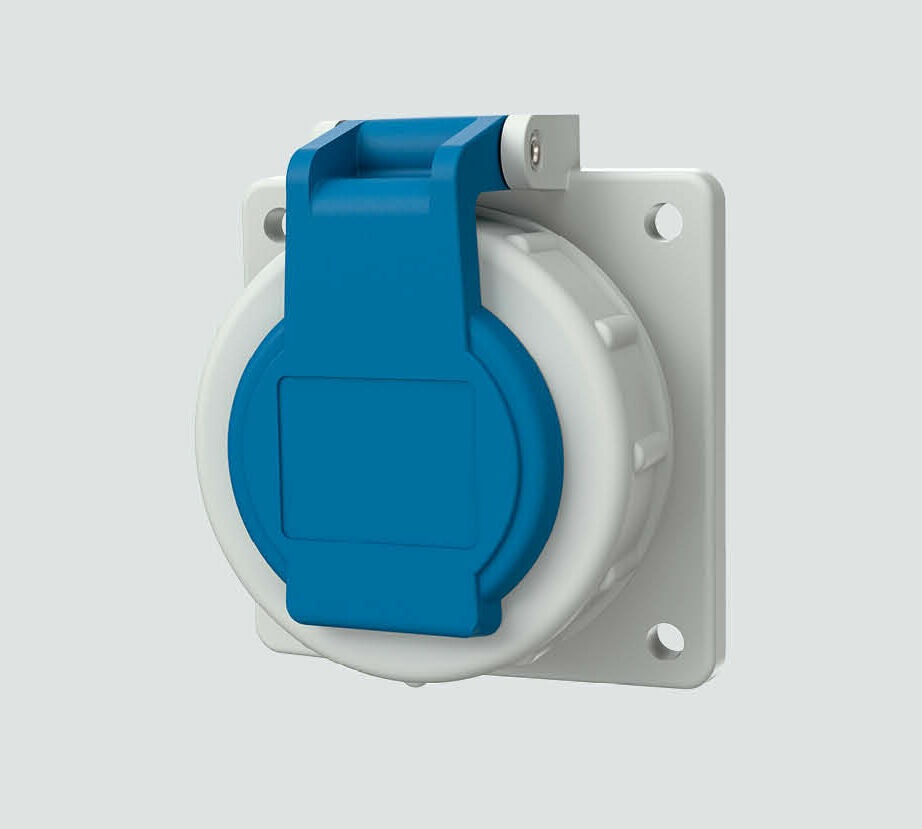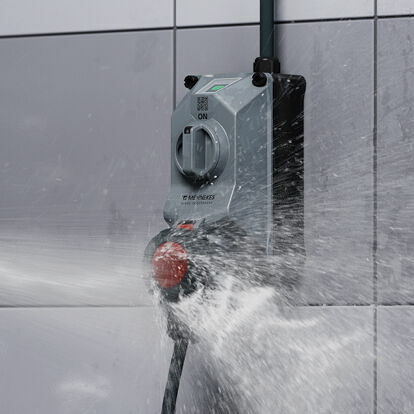What are IP protection types and IP protection classes?
IP (Ingress Protection) protective types specify what outer impacts plugs and sockets are protected against.
Protective classes describe the security measures in place that protect against hazardous voltages, electrocution, and other electrical accidents.

IP - Protection types
CEE plugs and sockets always need to operate reliably. Therefore they are subject to certain protective types. IP (Ingress Protection) types specify the degree of protection. Every IP protective type consists of two numbers. They indicate how well the inside of the device is protected aginst penetration through the device enclosure. The first number indicates the protections against touching, debris and dust. The second number indicates the protection against water. Every combination of numbers is defined by the European standard DIN EN/IEC 60529.
Sockets and connectors have to conform to the protective type when connected and disconnected. Plugs and inlets have to be protected according to the protective type when they are connected to their counterpart (connector or socket).
All CEE plugs and sockets have to conform to IP 44 or IP 67, CEE plugs and sockets with a rated current of 100/125 A always need IP 67 protection. Where sockets with a rated current of 100/125 A are integrated into an enclosure, the entire structure needs to have IP 44 protection.
A label on our plugs and sockets indicates the respective protective type.
This chart shows an overview of all IP protective types in accordance with DIN EN/IEC 60529 (for information about protective classes see further below):
In addition to product solutions in IP44 or IP67, we also offer particularly robust and disconnectable CEE sockets as well as plugs and couplings with IP67 / IP69 protection. These plugs and sockets remain watertight when submerged or subjected to high-pressure cleaning.
Ordinary SCHUKO® sockets in accordance with DIN VDE 0620 and DIN 49440 ff. can only conform to IP 44 protection when the hinged lid is fully closed, because their structural shape makes it impossible to avoid ingress of water at the protective conductor.

In addition to SCHOKO® socket outlets with the specified IP44 protection rating, we also offer socket outlets to SCHUKO® standard with IP68 protection rating for use in wet environments, such as harbours, swimming pools or outdoor areas.
Our plugs and sockets are labelled with the relevant protection class. You can find a detailed overview of the different types of protection and the meaning of the individual codes in our practical table on IP protection classes.
Table IP-protection types
| 1st number of the code | ||
|---|---|---|
| IEC 60529 | Protection against ingress of | Protection against contact with |
| 0 | No protection | No protection |
| 1 | Solid body larger than 50 mm | Back of hand |
| 2 | Solid body larger than 12.5 mm | Finger |
| 3 | Solid body larger than 2.5 mm | Tool |
| 4 | Solid body larger than 1 mm | Wire |
| 5 | Dust in harmful quantities | Complete protection against contact |
| 6 | Dust overall | Complete protection against contact |
| 2nd number of the code | |
|---|---|
| IEC 60529 | Protection against water |
| 0 | No protection |
| 1 | Drop of water falling vertically |
| 2 | Drop of water falling vertically on enclosure inclined by up to 15° |
| 3 | Protection against water spray falling at an angle up to 60° from the vertical |
| 4 | Protection against water sprayed from all directions |
| 5 | Protection against water jets (nozzle) from any angle |
| 6 | Protection against strong water jets |
| 7 | Protection against temporary submersion |
| 8 | Protection against continuous immersion |
| 9 | Protection against water during high-pressure/steam jet cleaning, specifically for agriculture |
IP - Protection classes
IP protection classes according to DIN EN 61140 / VDE0140-1
Protection classes describe the safety measures that protect against dangerous voltages/electrical shock and thus against an electrical accident. There are four protection classes: 0, 1, 2 and 3.
0: No additional protection besides basic insulation
1: Protective grounding
2: Protective insulation
3: Protective extra-low voltage
The protection classes for all electrical equipment are defined in the standards IEC 61140 or VDE 0140-1. The symbols to be used for marking the equipment are defined in the standard IEC 60417.



